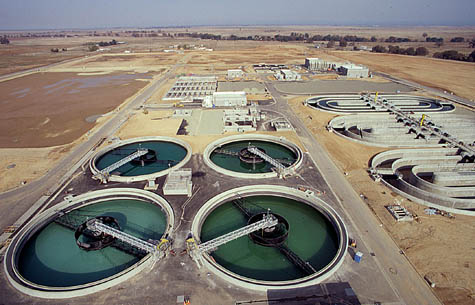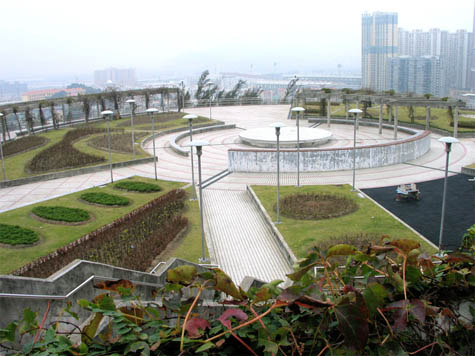 [Image: The wastewater treatment plant at Roseville, California, unrelated to the poem discussed below].
[Image: The wastewater treatment plant at Roseville, California, unrelated to the poem discussed below].For nearly four years now, without access to a good library, I've been looking for a poem called "Staines Waterworks" by the English poet Peter Redgrove; it's impossible to Google and, though I knew I'd actually photocopied it for myself nearly a decade ago, I had apparently lost the photocopies.
But, then, amidst the weird rolling peaks of recovery and amnesia that come with cleaning through your old books and papers in the family basement, I found a sheaf of old photocopies in a box about an hour ago – and inside it was "Staines Waterworks" by Peter Redgrove.
The poem is incredible for a variety of reasons; but its most basic impulse is to describe the water purification plant at Staines, west London (the hometown of Ali G), as a kind of previously overlooked alchemical process.
It is water "in its sixth and last purification" that "leaps from your taps like a fish," Redgrove writes.
- Rainwater gross as gravy is filtered from
Its coarse detritus at the intake and piped
To the sedimentation plant like an Egyptian nightmare,
For it is a hall of twenty pyramids upside-down
Balanced on their points each holding two hundred and fifty
Thousand gallons making thus the alchemical sign
For water and the female triangle.
Redgrove describes the movement of water through its various steps of industrial filtration, saying that it "reverberates... like some moon rolling / And thundering underneath [the] floors," passing through a "windowless hall of tides." It is a surrogate astronomy, surging through the replicant gravity of pumps and steel holding tanks.
The processed river water is then decanted, surveilled by automata, and "treated by poison gas, / The verdant chlorine which does not kill it." Beyond life, it is pushed through "anthracite beds," where Water meets Earth in an engineered encounter between the elements.
 [Image: A wastewater treatment plant in Macao, via Wikimedia, unrelated to the poem discussed in this post].
[Image: A wastewater treatment plant in Macao, via Wikimedia, unrelated to the poem discussed in this post].Later, in what Redgrove might call its fourth purification, the water at Staines flows past an underground structure that resembles "a castle," complete with "turrets / And doors high enough for a mounted knight in armour / To rein in." Dials here are read "as though [they are] the castle library."
- There are very few people in attendance,
All are men and seem very austere
And resemble walking crests of water in their white coats,
Hair white and long in honourable service.
Redgrove's poem – and I refer only to "Staines Waterworks" here, as I am not that familiar with his other work – shows the transformative power of description: give something an unexpected context and whole new, extraordinarily vibrant worlds can be created. This is more important, more lasting, and more interesting than much of what passes for architectural criticism today.
Finally, the baptized liquid at Staines reaches a point of biological and chemical clarity, after which it is re-introduced to the city through a labyrinth of pipework that extends in wild curlicues, a machinic Thames beneath western London. Scalded, filtered, purified, made artificially natural and ready for drinking, it is water born again for future uses.
No comments:
Post a Comment